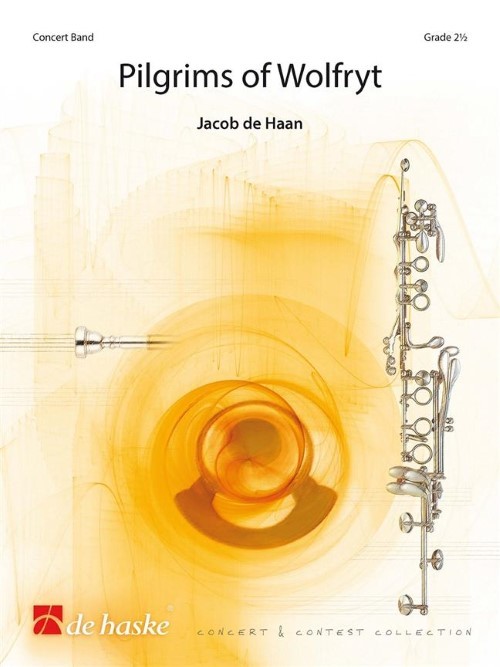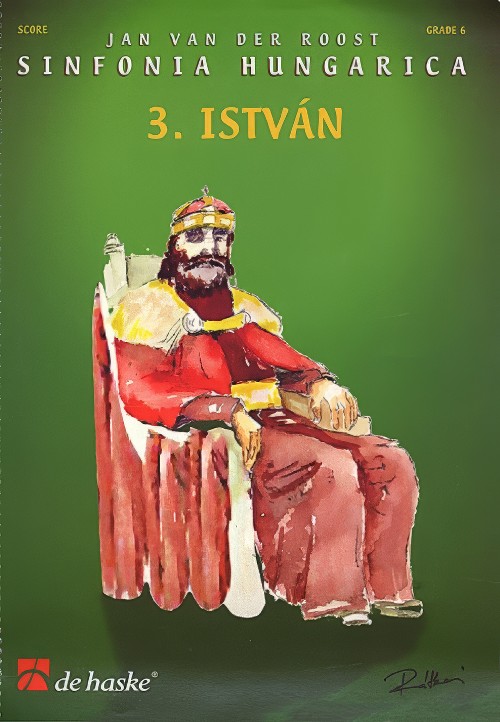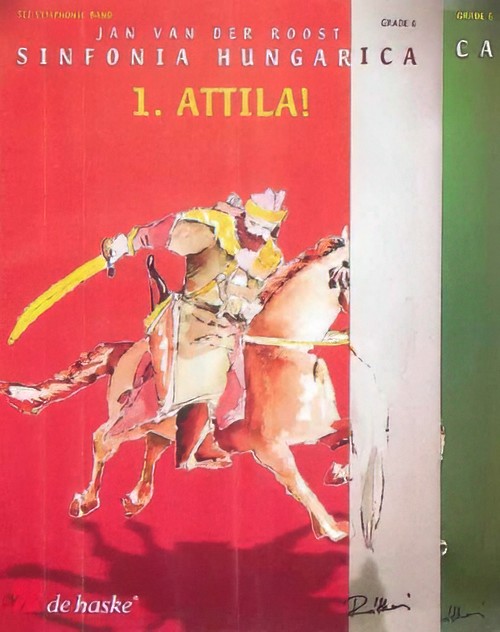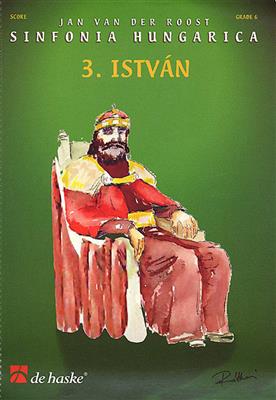Results
-
 £202.99
£202.99Gloriosa - Symphonic Poem for Band Movement 1 - Yasuhide Ito
A new acquisition by Bravo Music, this fresh printing of the 1990 masterwork by Yasuhide Ito features a newly engraved score, improved parts, good availability and value. This stirring and powerful homage to early Christianity in Japan profoundly and eloquently states the case of cross-cultural conflict and resolution.I. OratioThe Gregorian chant "Gloriosa" begins with the words, "O gloriosa Domina excelsa super sidera que te creavit provide lactasti sacro ubere." The first movement Oratio opens with bells sounding the hymn's initial phrases. The movement as a whole evokes the fervent prayers and suffering of the Crypto-Christians.II. CantusIII. Dies FestusCommissioned in 1989 and premiered in 1990 by the Sasebo Band of the Maritime Self-Defense Force of Kyushu, southern Japan.Gloriosa is inspired by the songs of the Kakure-Kirishitan (Crypto-Christians) of Kyushu who continued to practice their faith surreptitiously after the ban of Christianity, which had been introduced to that southern region in the mid-16th century by Roman Catholic missionary Francisco Xavier. The worship brought with it a variety of western music.Though Christianity was proscribed in 1612 by authority of the Tokugawa Shogunate in Edo (today Tokyo), Kakure-Kirishitan continued advocating sermons and disguised songs. Melodies and lyrics such as Gregorian chant were obliged to be "Japanized". For example, the Latin word "Gloriosa" was changed to "Gururiyoza." This adaptation of liturgy for survival inspired Ito to write this piece in order to reveal and solve this unique cultural mystery.The composer explains:"Nagasaki district in Kyushu region continued to accept foreign culture even during the seclusion period, as Japan's only window to the outer world. After the proscription of Christianity, the faith was preserved and handed down in secret in the Nagasaki and Shimabara areas of Kyushu region. My interest was piqued by the way in which the Latin words of Gregorian chants were gradually `Japanized' during the 200 years of hidden practice of the Christian faith. That music forms the basis of Gloriosa."Gloriosa, fusing Gregorian chant and Japanese folk music, displays the most sophisticated counterpoint yet found in any Japanese composition for wind orchestra.
Estimated dispatch 7-14 working days
-
£209.99
Gloriosa - Symphonic Poem for Band Mvt 2 & 3 - Yasuhide Ito
A new acquisition by Bravo Music, this fresh printing of the 1990 masterwork by Yasuhide Ito features a newly engraved score, improved parts, good availability and value. This stirring and powerful homage to early Christianity in Japan profoundly and eloquently states the case of cross-cultural conflict and resolution.I. OratioThe Gregorian chant "Gloriosa" begins with the words, "O gloriosa Domina excelsa super sidera que te creavit provide lactasti sacro ubere." The first movement Oratio opens with bells sounding the hymn's initial phrases. The movement as a whole evokes the fervent prayers and suffering of the Crypto-Christians.II. CantusIII. Dies FestusCommissioned in 1989 and premiered in 1990 by the Sasebo Band of the Maritime Self-Defense Force of Kyushu, southern Japan.Gloriosa is inspired by the songs of the Kakure-Kirishitan (Crypto-Christians) of Kyushu who continued to practice their faith surreptitiously after the ban of Christianity, which had been introduced to that southern region in the mid-16th century by Roman Catholic missionary Francisco Xavier. The worship brought with it a variety of western music.Though Christianity was proscribed in 1612 by authority of the Tokugawa Shogunate in Edo (today Tokyo), Kakure-Kirishitan continued advocating sermons and disguised songs. Melodies and lyrics such as Gregorian chant were obliged to be "Japanized". For example, the Latin word "Gloriosa" was changed to "Gururiyoza." This adaptation of liturgy for survival inspired Ito to write this piece in order to reveal and solve this unique cultural mystery.The composer explains:"Nagasaki district in Kyushu region continued to accept foreign culture even during the seclusion period, as Japan's only window to the outer world. After the proscription of Christianity, the faith was preserved and handed down in secret in the Nagasaki and Shimabara areas of Kyushu region. My interest was piqued by the way in which the Latin words of Gregorian chants were gradually `Japanized' during the 200 years of hidden practice of the Christian faith. That music forms the basis of Gloriosa."Gloriosa, fusing Gregorian chant and Japanese folk music, displays the most sophisticated counterpoint yet found in any Japanese composition for wind orchestra.
Estimated dispatch 7-14 working days
-
 £104.99
£104.99Pilgrims of Wolfryt (Concert Band - Score and Parts) - De Haan, Jacob
The work Pilgrims of Wolfryt tells the story of the legend Walfridus (also known as Wolfryt), a resident of the town of Bedum in the Netherlands who was born in the 11th century. Wilfridus had an eventful life: he introduced Christianity to Bedum and helped the town build its first legal system, but ultimately his story ended in demise - murdered alongside his son at the hands of the Vikings. Pilgrims of Wolfryt is a symphonic poem-like masterpiece, full of evocative melodies in a mix of tonalities to make the most of the impressive rhythmic material.Duration: 9.00
Estimated dispatch 7-14 working days
-
 £239.99
£239.99Istvan (Part 3 from Sinfonia Hungarica) (Concert Band - Score and Parts) - Van der Roost, Jan
Sinfonia Hungarica is a three-movement symphony that depicts the history of Hungary. All three movements were inspired by historical key figures, wars, and other important events from this country. This symphony is a celebration of Hungary's millennium in 2001.The final movement is named after Istvan, the King who introduced Christianity into Hungary and who was crowned by Pope Silvestro II on January 1, 1001. A rather solemn start leads to another war-like passage, ending with some loud crashes. This symbolizes the fact that the body of the pagan Koppany was cut into four pieces, and sent to the four castles of the country as an example. After a quiet, almost religious intermezzo, the National Hymn of Hungary is introduced. This broad "grandioso" ending also has a symbolic meaning: after ten centuries, Hungary has many reasons to look back on the past with pride, and to look forward to the future with optimism and confidence.Duration: 14:30
Estimated dispatch 7-14 working days
-
 £551.99
£551.99Sinfonia Hungarica (Concert Band - Score and Parts) - Van der Roost, Jan
This three-movement symphony musically depicts the history of Hungary. Key historical figures, wars and other important events from this country inspired all three movements. The first movement depicts Atilla, the King of the Huns, and is characterised by fear, threat and aggression. The second movement focuses on Arpad, the founder of the Hungarian State and the final movement is named after Istvan, the King who introduced Christianity into Hungary. The beautiful theme of the national hymn appears throughout the symphony, however it is often partially hidden. It is used as a "thread," hardly recognizable at the beginning, becoming more and more obvious near the end and it concludes the symphony as the "final apotheosis," making the band sound like a majestic living organ.Duration: 12:45
Estimated dispatch 7-14 working days
-
 £84.99
£84.99St. Patrick Dances (Concert Band - Score and Parts)
In 432 St. Patrick traveled from Scotland to Ireland and within a few years he succeeded in converting the entire Irish population to Christianity. The bishop died on 17th March 461 and in Ireland, as a tribute to this remarkable bishop, this date became a national holiday called St. Patrick's Day. St. Patrick's Day, symbolized by the shamrock, is one big party with traditional Irish dancing, parades with highly decorated floats, hundreds of concerts and all kinds of colorful characters on the streets. Bring a touch of Irish magic to any concert with this lively composition. 02:15
Estimated dispatch 7-14 working days
-
 £104.99
£104.99Pilgrims of Wolfryt - Jacob de Haan
The work Pilgrims of Wolfryt tells the story of the legend Walfridus (also known as Wolfryt), a resident of the town of Bedum in the Netherlands who was born in the 11th century. Wilfridus had an eventful life: he introduced Christianity to Bedum and helped the town build its first legal system, but ultimately his story ended in demise murdered alongside his son at the hands of the Vikings. Pilgrims of Wolfryt is a symphonic poem-like masterpiece, full of evocative melodies in a mix of tonalities to make the most of the impressive rhythmic material.
Estimated dispatch 7-14 working days
-
 £239.99
£239.99Istvn (part 3 from 'Sinfonia Hungarica') - Jan Van der Roost
Sinfonia Hungarica is a three-movement symphony that depicts the history of Hungary. All three movements were inspired by historical key figures, wars, and other important events from this country. This symphony is a celebration of Hungary's millennium in 2001.The final movement is named after ISTVAN, the King who introduced Christianity into Hungary and who was crowned by Pope Silvestro II on January 1, 1001. A rather solemn start leads to another war-like passage, ending with some loud crashes. This symbolizes the fact that the body of the pagan Koppany was cut into four pieces, and sent to the four castles of the country as an example. After a quiet, almost religiousintermezzo, the National Hymn of Hungary is introduced. This broad "grandioso" ending also has a symbolic meaning: after ten centuries, Hungary has many reasons to look back on the past with pride, and to look forward to the future with optimism and confidence.
Estimated dispatch 7-14 working days
-
£271.60
Ljodgata - Torstein Aagaard-Nilsen
The old Norwegian name Ljodgata means the main road. This road (or path) has existed since the iron age. In 12 century christians walked from Oslo to Nidaros (Trondheim) to visit the Cathedral containing the tomb of King Olav the Holy. Part 1 The Tomb and the Church is a musical picture of religious activities in the area. The tomb of King Rakne, one of the largest graves in the northern Europa is now a monument in the area, even if Hovin Church has been a symbol of christianity sincethe 1400 century. Part 2 The Woods of Trandum Pictures the military acitivities that has been going on for more that 250 years. During the 2nd World War, an execution of innocent people took place in the woods. Part 3 Jetset Picture of the present.The international airport at Gardermoen has made the village Jessheim become a town. People now live moderne city lives.
Estimated dispatch 7-14 working days
-
 £84.99
£84.99St. Patrick Dances - Johan Nijs
In 432 St. Patrick traveled from Scotland to Ireland and within a few years he succeeded in converting the entire Irish population to Christianity. The bishop died on 17th March 461 and in Ireland, as a tribute to this remarkable bishop, this date became a national holiday called St. Patrick's Day. St. Patrick's Day, symbolized by the shamrock, is one big party with traditional Irish dancing, parades with highly decorated floats, hundreds of concerts and all kinds of colorful characters on the streets. Bring a touch of Irish magic to any concert with this lively composition.
Estimated dispatch 7-14 working days
